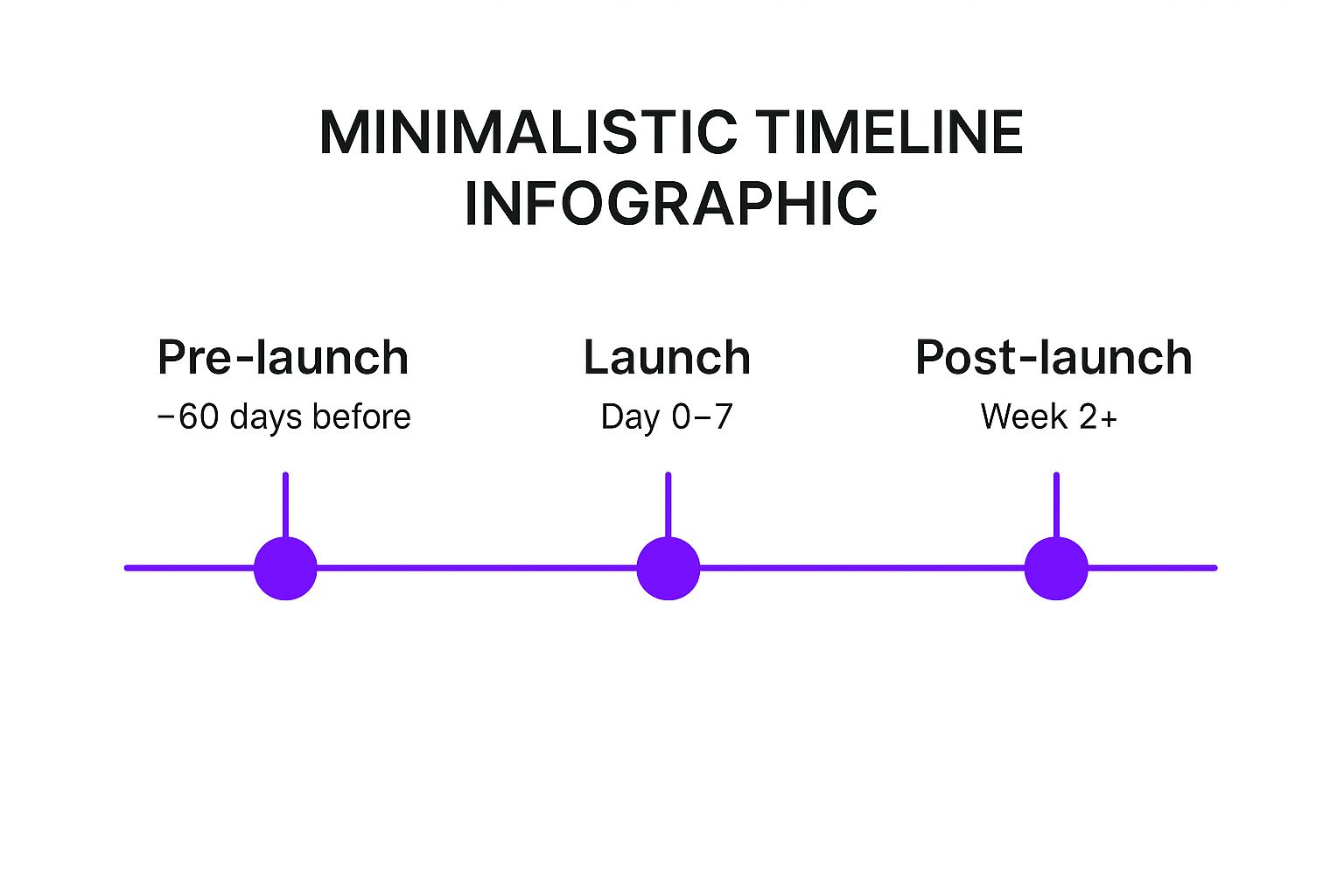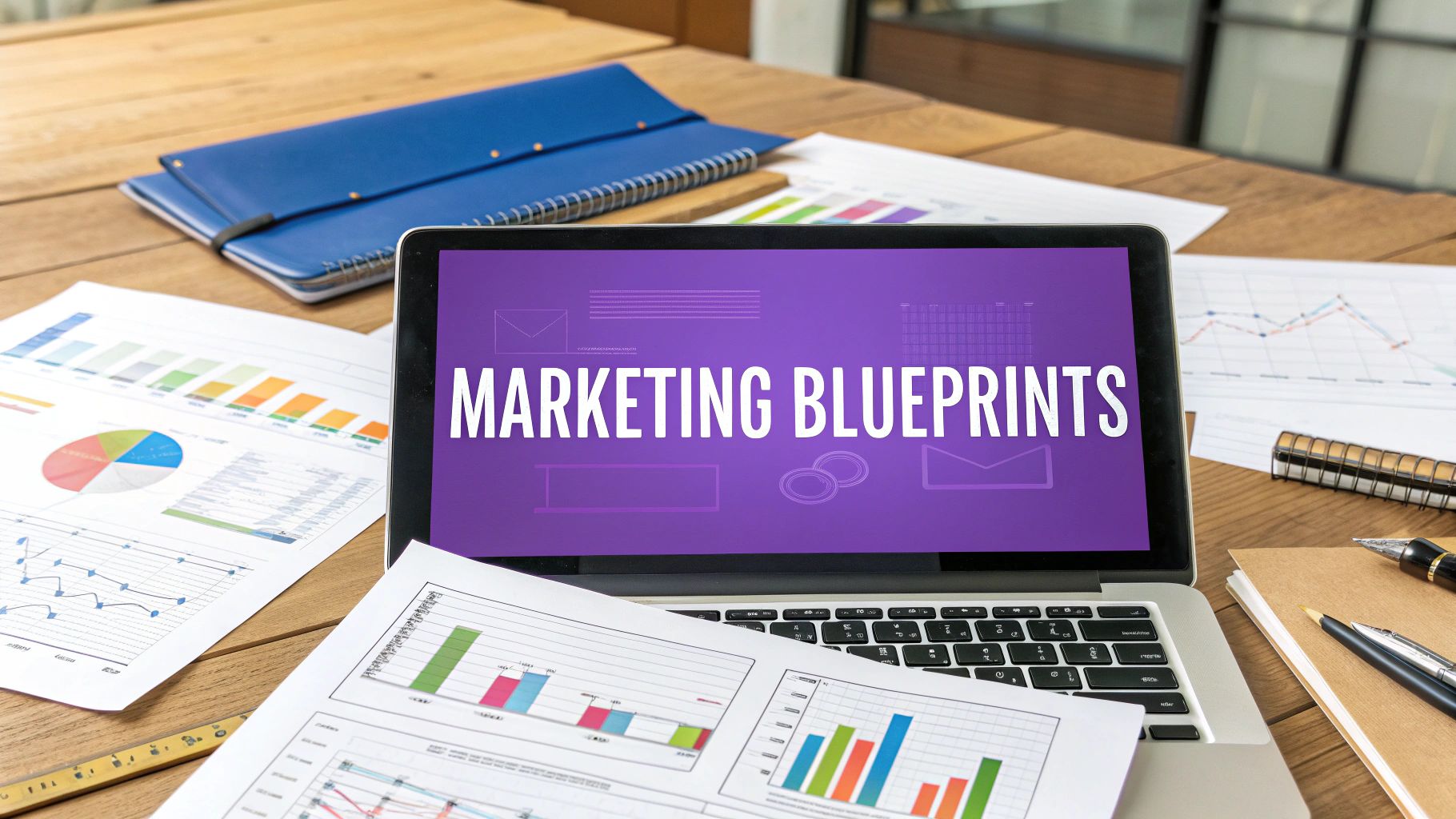8 Marketing Plan Strategy Sample Blueprints for 2025
A great marketing plan is more than a document; it's a strategic roadmap that guides every decision, from budget allocation to campaign execution. Yet, many businesses struggle to move from a generic template to a dynamic, actionable strategy that drives real growth. This guide is designed to break down that ambiguity by moving beyond theory and into practical application.
We will dissect eight distinct marketing plan strategy sample blueprints, analyzing the core components, strategic thinking, and tactical execution behind each one. You'll gain a deeper understanding of how to select, adapt, and implement these frameworks for your own business, transforming your marketing from guesswork into a predictable growth engine.
This article isn't just a list; it's a deep dive into what makes these plans successful. We'll explore everything from a comprehensive Content Marketing Strategy to a targeted Customer Retention & Loyalty Marketing Strategy. Whether you're a startup founder, a seasoned marketer, or leading a team, these examples provide the clarity and inspiration needed to craft a plan that delivers measurable, impactful results. Let's get started.
1. Content Marketing Strategy
A content marketing strategy is a strategic approach focused on creating and distributing valuable, relevant, and consistent content to attract and retain a clearly-defined audience. Unlike direct advertising, this method builds long-term brand equity, establishes thought leadership, and nurtures customer relationships by providing genuine value before asking for a sale. It’s a foundational piece of any modern marketing plan strategy sample because it fuels other channels like social media, SEO, and email marketing.

This strategy hinges on understanding your audience’s pain points and answering their questions. Instead of pitching products, you create resources that solve their problems, positioning your brand as a trusted expert.
Strategic Breakdown & Actionable Takeaways
HubSpot is a prime example, generating over 4.5 million monthly visitors to its blog and resource library. They don't just sell CRM software; they teach businesses how to grow with comprehensive guides, templates, and courses on every marketing and sales topic imaginable.
How to Apply This Strategy:
- Develop Buyer Personas: Before writing a single word, create detailed profiles of your ideal customers. Understand their goals, challenges, and what information they are actively searching for.
- Create an Editorial Calendar: Plan your content in advance. A consistent publishing schedule keeps your audience engaged and signals to search engines that your site is a fresh source of information.
- Focus on Problem-Solving: Every piece of content should address a specific customer question or problem. Marcus Sheridan’s "They Ask, You Answer" methodology is a perfect framework for this.
- Repurpose Content: Maximize your efforts by turning one asset into many. A blog post can become a video, an infographic, a series of social media posts, or a podcast episode. For a deeper dive, you can learn more about creating a complete content strategy template.
This approach is highly effective for businesses with a longer sales cycle, B2B companies, and any brand aiming to build lasting customer loyalty over quick wins.
2. Social Media Marketing Strategy
A social media marketing strategy is a comprehensive plan detailing how a business will use social media platforms to connect with its target audience, build brand awareness, and achieve marketing objectives. More than just posting updates, this strategy involves platform selection, content creation, community engagement, and performance analytics. It transforms social channels from simple broadcasting tools into powerful platforms for building relationships, generating leads, and driving sales.

This strategy is effective because it meets customers where they are already spending their time. By delivering platform-native content that entertains, educates, or inspires, brands can foster a loyal community and stay top-of-mind.
Strategic Breakdown & Actionable Takeaways
Wendy's iconic Twitter presence serves as a masterclass in this strategy. Their witty, humorous, and sometimes-savage brand voice created viral moments and generated massive earned media, all while feeling authentic to the platform's culture. They engage directly with users and other brands, turning their feed into a source of entertainment, not just advertisements.
How to Apply This Strategy:
- Select Platforms Wisely: Don't try to be everywhere. Focus on 2-3 platforms where your buyer personas are most active. A B2B firm will find more value on LinkedIn, while a visual-heavy fashion brand will thrive on Instagram or Pinterest.
- Create Platform-Native Content: Avoid cross-posting the same message everywhere. A professional article for LinkedIn should be adapted into a short, engaging video for TikTok or a visually compelling carousel for Instagram.
- Engage Authentically and Consistently: Social media is a two-way conversation. Respond to comments, answer direct messages, and participate in relevant discussions. Consistency in both posting and engagement builds trust and community.
- Leverage Analytics for Optimization: Use built-in platform analytics to track what works. Monitor metrics like engagement rates, reach, and click-throughs to refine your content types and posting schedule.
This approach is essential for B2C brands, e-commerce stores, and any business aiming to build a strong community and drive direct engagement with its customer base.
3. Email Marketing Strategy
An email marketing strategy is a direct communication channel used to nurture leads, engage customers, and drive sales through targeted email campaigns. It remains a cornerstone of digital marketing due to its high ROI, allowing businesses to build direct relationships with their audience. This component is essential in a marketing plan strategy sample because it provides a direct line to the customer, fostering loyalty and encouraging repeat business away from the noise of social media.
This strategy revolves around delivering personalized and valuable content directly to a user's inbox. By segmenting audiences and automating communication based on user behavior, brands can send highly relevant messages that resonate and convert.
Strategic Breakdown & Actionable Takeaways
Airbnb excels at this with its personalized travel recommendations and booking reminders. They use data from a user's past searches, wish lists, and bookings to send tailored emails that inspire the next trip, making the user feel understood and catered to. This data-driven approach turns a simple email into a powerful conversion tool.
How to Apply This Strategy:
- Build Your List Organically: Offer genuine value in exchange for an email address. Use lead magnets like free ebooks, checklists, or exclusive discounts to attract subscribers who are genuinely interested in your brand.
- Segment Your Audience: Don't send the same message to everyone. Group your subscribers based on their purchase history, on-site behavior, or demographic data to send highly relevant and personalized content.
- Automate Customer Journeys: Set up automated email sequences for key actions, such as a welcome series for new subscribers, abandoned cart reminders for e-commerce shoppers, or re-engagement campaigns for inactive users.
- Write Compelling Subject Lines: Your subject line is your first impression. A/B test different formats to see what drives the highest open rates, but focus on creating curiosity and clearly communicating value.
This strategy is highly effective for e-commerce businesses, B2B companies nurturing long-term leads, and any brand focused on building a loyal community and driving repeat purchases.
4. Search Engine Optimization (SEO) Strategy
A search engine optimization (SEO) strategy is a comprehensive approach designed to increase a website's visibility in organic (non-paid) search engine results. By optimizing on-page content, technical website elements, and off-page authority signals, this strategy aims to rank higher for relevant keywords, driving qualified and consistent traffic. SEO is a critical component of any digital marketing plan strategy sample because it captures users with high purchase intent at the exact moment they are searching for solutions.
This strategy revolves around demonstrating relevance and authority to search engines like Google. It’s a long-term investment that builds a sustainable source of leads and sales by aligning your website with the algorithms that determine search rankings.
Strategic Breakdown & Actionable Takeaways
Backlinko is a masterclass in SEO execution. Founder Brian Dean built a multi-million dollar business by creating in-depth, highly actionable content that ranks for hyper-competitive keywords. Instead of publishing frequently, he focuses on creating definitive "skyscraper" resources that attract thousands of backlinks and dominate search results for terms like "SEO tools" and "link building."
How to Apply This Strategy:
- Prioritize Search Intent: Move beyond simply stuffing keywords. Analyze the top-ranking pages for your target query to understand if users are looking for informational guides, product comparisons, or direct purchase options, and structure your content to match that intent.
- Conduct a Technical SEO Audit: Ensure your website is fast, mobile-friendly, and easy for search engines to crawl. Use tools like Google's PageSpeed Insights to check for Core Web Vitals issues that could be holding your site back.
- Build Authority with Quality Backlinks: Create valuable, link-worthy assets like original research, free tools, or comprehensive guides. Promote these assets through targeted outreach to journalists, bloggers, and industry publications to earn authoritative links.
- Optimize for Local Search: For service-based or brick-and-mortar businesses, optimizing your Google Business Profile is non-negotiable. Consistently gather reviews, add photos, and ensure your name, address, and phone number (NAP) are consistent across the web.
SEO is ideal for businesses seeking sustainable, long-term growth. It is particularly effective for e-commerce stores, B2B companies with a high-value customer lifecycle, and local businesses competing for "near me" searches.
5. Influencer Marketing Strategy
An influencer marketing strategy leverages partnerships with individuals who have established credibility and a dedicated following within a specific niche. Rather than broadcasting a message to a wide audience, this approach taps into the trust and authenticity an influencer has built with their followers. It’s a powerful component of a modern marketing plan strategy sample because it uses social proof and word-of-mouth at scale.

This strategy hinges on finding the right partners whose audience perfectly matches your target customer. The goal is to create genuine endorsements that feel like a trusted recommendation from a friend, not a paid advertisement.
Strategic Breakdown & Actionable Takeaways
Gymshark is a masterclass in influencer marketing, growing from a small startup into a billion-dollar brand by partnering with fitness athletes and creators. They built a community of "Gymshark Athletes" who genuinely used and loved the products, turning brand promotions into aspirational lifestyle content that resonated deeply with the fitness community.
How to Apply This Strategy:
- Prioritize Audience Alignment: Focus on the influencer's audience demographics and engagement rates, not just their follower count. A micro-influencer with a highly engaged, niche audience can deliver a much better ROI than a celebrity with millions of passive followers.
- Develop Clear Campaign Briefs: Provide influencers with clear goals, key messaging points, and deliverables, but allow them the creative freedom to present the information in their own authentic voice. Their audience follows them for their unique style.
- Track Performance with Unique Codes: Use unique discount codes or trackable links (like UTM parameters) for each influencer. This allows you to accurately measure traffic, conversions, and the overall ROI of your campaign.
- Build Long-Term Relationships: Shift from one-off transactional posts to long-term ambassadorships. Sustained partnerships feel more genuine to the audience and can lead to more impactful and cost-effective results over time.
This approach is especially effective for consumer brands in visually-driven industries like fashion, beauty, fitness, and food, as well as any business aiming to build rapid trust and brand awareness with a targeted demographic.
6. Pay-Per-Click (PPC) Advertising Strategy
A Pay-Per-Click (PPC) advertising strategy is a digital marketing model where businesses pay a fee each time their ad is clicked. This method allows companies to "buy" visits to their site rather than attempting to "earn" those visits organically. Platforms like Google Ads and Meta Ads enable highly targeted campaigns that drive immediate, high-intent traffic, making it a powerful component of a comprehensive marketing plan strategy sample.
This strategy is about precision and speed. By bidding on specific keywords or targeting detailed user demographics, brands can place their message directly in front of potential customers at the exact moment they are searching for a solution, leading to faster conversions and measurable results.
Strategic Breakdown & Actionable Takeaways
Amazon is a master of this, dominating Google Ads for millions of high-intent keywords like "buy running shoes" or "laptop deals." They capture users at the peak of their purchase intent, directing them straight to a relevant product page. Similarly, local service businesses like plumbers bid aggressively on "emergency plumber near me" to capture urgent, high-value leads.
How to Apply This Strategy:
- Implement Robust Conversion Tracking: Before spending a dollar, ensure tracking is set up correctly. You need to know exactly which keywords, ads, and campaigns are driving actual sales or leads, not just clicks.
- Create Tightly Themed Ad Groups: Don't lump hundreds of keywords into one ad group. Instead, create small, focused groups (e.g., one for "red running shoes," another for "blue running shoes") with highly relevant ads. This improves your Quality Score and lowers costs.
- Utilize Negative Keywords: Actively add negative keywords to your campaigns to prevent your ads from showing for irrelevant searches. This simple step saves a significant portion of your budget and improves lead quality.
- Leverage Ad Extensions: Use sitelinks, callouts, and structured snippets to make your ads bigger and more informative. This increases click-through rates and provides more value to the user before they even click. To broaden your reach, you can learn more about an effective Facebook PPC advertising strategy.
PPC is ideal for businesses seeking immediate traffic, testing new product offers, or capturing high-intent customers in competitive markets. It offers unparalleled control and scalability for driving growth.
7. Product Launch Marketing Strategy
A product launch marketing strategy is a comprehensive, time-sensitive plan designed to introduce a new product or service to the market with maximum impact and adoption. This strategy coordinates multiple channels to build anticipation before the launch, execute a powerful release, and sustain momentum afterward. It's a critical component of any marketing plan strategy sample when introducing something new, as it orchestrates excitement and drives initial sales velocity.
This strategy hinges on creating a narrative and building a sense of eventfulness around the product. Instead of simply making a product available, you turn its release into a must-see moment that captures audience and media attention.
Strategic Breakdown & Actionable Takeaways
Apple’s iPhone launches are the gold standard. They build suspense for months with keynote events, controlled media leaks, and a perfectly synchronized retail experience, turning each release into a global cultural event. Similarly, Dollar Shave Club’s viral video launch disrupted an entire industry with a low-budget, high-impact approach that perfectly captured their brand voice.
The following infographic outlines the typical timeline for a structured product launch, breaking it down into three core phases.

This timeline illustrates that the work done in the 60 days leading up to launch is just as important as the launch week itself.
How to Apply This Strategy:
- Build Anticipation Early: Start teasing your launch 2-3 months in advance with behind-the-scenes content, countdowns, and sneak peeks to build an engaged waitlist.
- Coordinate a Multi-Channel Blitz: On launch day, ensure your message is consistent and amplified across all channels simultaneously: PR, email, social media, paid ads, and influencer collaborations.
- Create an Early Access Program: Reward your most loyal customers and influencers with exclusive early access. This generates initial testimonials and social proof while making others eager to join.
- Plan for Post-Launch Momentum: The launch isn't over after day one. Prepare follow-up content, customer success stories, and promotions to maintain interest and convert hesitant buyers.
This approach is essential for any business introducing a new product, feature, or service. It's particularly effective for creating market disruption and capturing significant market share quickly.
8. Customer Retention & Loyalty Marketing Strategy
A customer retention and loyalty marketing strategy is a strategic approach focused on maximizing customer lifetime value by increasing repeat purchases and reducing churn. Rather than constantly chasing new leads, this strategy prioritizes nurturing existing relationships through personalized communication, reward programs, and exceptional customer experiences. It is a vital part of any marketing plan strategy sample because retaining a customer is 5-25 times more cost-effective than acquiring a new one.
This approach transforms one-time buyers into long-term brand advocates. The core principle is that a happy, engaged customer is more likely to buy again, spend more, and refer others, creating a sustainable growth loop for the business.
Strategic Breakdown & Actionable Takeaways
Starbucks is a master of this strategy, with its Rewards program driving over 50% of its revenue. Through its mobile app, the company creates a seamless ecosystem of personalized offers, gamified challenges, and convenient ordering that keeps customers deeply engaged and consistently coming back.
How to Apply This Strategy:
- Segment Your Customer Base: Group customers based on their purchase history, frequency, and lifetime value. This allows you to tailor retention efforts, such as offering exclusive perks to top-tier clients or running re-engagement campaigns for at-risk segments.
- Implement a Value-Driven Loyalty Program: Go beyond simple discounts. Offer tiered benefits, exclusive access to products, or special experiences that make customers feel valued and recognized for their loyalty.
- Focus on Proactive Customer Service: Use exceptional service as a marketing tool. Zappos built its brand by empowering its support team to go above and beyond, creating powerful word-of-mouth marketing and lifelong advocates.
- Gather and Act on Feedback: Regularly survey your customers to understand their satisfaction levels and identify areas for improvement. For long-term success, marketing plans must include concrete strategies to reduce churn rate and cultivate customer loyalty, ensuring sustained growth.
This strategy is particularly effective for subscription businesses, e-commerce stores, and service-based companies where repeat business is the cornerstone of profitability. For more ideas, you can learn more about customer retention marketing tactics.
Marketing Strategy Comparison Matrix
| Content Marketing Strategy | Moderate to High: Requires consistent content creation and diverse skills | Medium-High: Multi-channel content creation and SEO focus | Long-term organic traffic growth, brand authority, customer loyalty | Brands aiming for sustained growth and authority building | Cost-effective, builds trust, supports other marketing efforts |
|---|---|---|---|---|---|
| Social Media Marketing Strategy | High: Platform-specific optimization and real-time engagement needed | Medium-High: Continuous content management and paid ads | Direct audience engagement, viral reach, brand awareness | Businesses seeking active audience interaction and fast feedback | Real-time engagement, detailed analytics, viral potential |
| Email Marketing Strategy | Moderate: Segmentation, automation, and compliance must be managed | Low to Medium: Email tools and CRM integrations | High ROI, direct conversions, measurable and scalable campaigns | Companies focused on retention, conversion, and lead nurturing | Highest ROI, direct customer communication, scalable automation |
| SEO Strategy | High: Demanding on technical, content, and link-building efforts | Medium: Requires specialized expertise and tools | Sustainable organic traffic, higher search rankings, increased trust | Websites targeting long-term growth and organic visibility | Long-term cost-effectiveness, credibility, valuable insights |
| Influencer Marketing Strategy | High: Influencer identification, relationship management, content coordination | Medium-High: Influencer compensation and management | Increased awareness, engagement, and authentic endorsements | Brands targeting niche or younger demographics | Authentic content, high engagement, access to targeted audiences |
| PPC Advertising Strategy | Moderate to High: Needs ongoing campaign optimization and bidding | Medium-High: Budget for clicks and ad management | Immediate traffic, measurable ROI, quick lead and sales generation | Businesses requiring fast results and precise targeting | Immediate results, flexible budget, precise audience targeting |
| Product Launch Marketing Strategy | Very High: Multi-phase, cross-channel coordination, high upfront effort | High: Requires intensive resources and pre-launch investment | Concentrated market buzz, rapid sales adoption, and momentum building | New product/service introductions needing maximum impact | Creates buzz, drives fast sales, structured phased execution |
| Customer Retention & Loyalty | Moderate to High: Data-driven segmentation, personalization, and program management | Medium-High: CRM, analytics, and loyalty program investment | Higher customer lifetime value, reduced churn, repeat purchases | Businesses focused on maximizing existing customer value | Increased profitability, predictable revenue, customer advocacy |
Crafting Your Integrated Marketing Blueprint
We've explored a diverse array of marketing plan strategy samples, from the foundational pillars of SEO and content marketing to the dynamic engines of PPC advertising and influencer collaborations. Each example offers a unique framework, but the most profound lesson is that no single strategy operates in a vacuum. The true power lies not in choosing one path, but in weaving several together to create a cohesive, multi-channel engine that drives sustainable growth.
A powerful content marketing strategy, for instance, loses its impact without a robust SEO plan to ensure visibility. Similarly, an ambitious product launch can achieve exponential reach when amplified by a synchronized influencer and social media campaign. The key is to move beyond isolated tactics and embrace an integrated mindset. To truly achieve a cohesive and effective overall strategy, understanding all components of your outreach is vital, including what integrated marketing communications (IMC) entails. This holistic view ensures that every action, from a single email to a major ad spend, works in concert to achieve your overarching business goals.
From Sample to System: Your Actionable Next Steps
Viewing a marketing plan strategy sample is the first step; adapting it into a living, breathing system for your business is the next. Here is how you can transform inspiration into implementation:
Start with Your Core Objective: Before selecting any strategy, define your single most important goal. Is it generating qualified leads for your service firm, driving direct sales for your e-commerce store, or building brand authority in a new market? Your primary objective will serve as your compass.
Select Your Anchor Strategy: Choose the one strategy from our list that most directly addresses your core objective. For brand awareness, a content or influencer strategy might be your anchor. For immediate sales, a PPC or product launch plan could be the starting point.
Layer on Supporting Strategies: Once your anchor is in place, identify two to three complementary strategies that will amplify its effects. If your anchor is SEO, support it with a consistent content strategy to create assets that rank and a customer retention strategy to nurture the traffic you acquire.
Define Your Metrics and KPIs: For each chosen strategy, establish clear, measurable Key Performance Indicators (KPIs). For SEO, this could be organic traffic and keyword rankings. For email marketing, it might be open rates, click-through rates, and conversion rates. This data-driven approach is non-negotiable for understanding what works.
Build a Phased Roadmap: Don't try to implement everything at once. Create a quarterly roadmap that outlines which initiatives you will launch and when. This makes your comprehensive plan manageable and allows you to build momentum over time, turning a collection of sample strategies into a personalized blueprint for success.
Ultimately, the goal is to build a marketing ecosystem where each part strengthens the whole. By thoughtfully combining the frameworks we've discussed, you can move beyond piecemeal tactics and construct a strategic, integrated plan that not only reaches your audience but also builds lasting relationships and delivers measurable business results.
Feeling overwhelmed turning these samples into a cohesive, high-performance plan? The expert team at Rebus specializes in crafting and executing integrated marketing strategies tailored to your unique business goals. Let us help you build the data-driven blueprint you need to achieve predictable growth by visiting Rebus to schedule a consultation.
